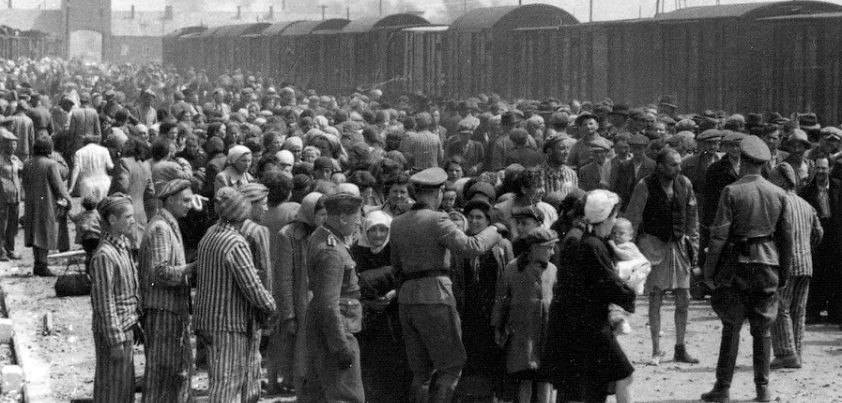 This almost clinical account of Tadeusz Borowski’s holocaust experiences explores an often overlooked aspect of the so-called “final solution”: how general prisoners forced to assist in sending the condemned to gas chambers became so desensitized to the brutality that many actively participated in it. Because of their access to discarded food and clothing, these men formed the “elite” among the prisoner hierarchy. In camp, their insensitivity to suffering prevailed and many looked down on and showed little compassion for the plight of “less fortunate” fellow inmates. Themes: man’s inhumanity to man, death and suffering, the survival instinct, detachment, guilt, rationalization. More…
This almost clinical account of Tadeusz Borowski’s holocaust experiences explores an often overlooked aspect of the so-called “final solution”: how general prisoners forced to assist in sending the condemned to gas chambers became so desensitized to the brutality that many actively participated in it. Because of their access to discarded food and clothing, these men formed the “elite” among the prisoner hierarchy. In camp, their insensitivity to suffering prevailed and many looked down on and showed little compassion for the plight of “less fortunate” fellow inmates. Themes: man’s inhumanity to man, death and suffering, the survival instinct, detachment, guilt, rationalization. More…
Category Archives: Short Stories
The Minister’s Black Veil
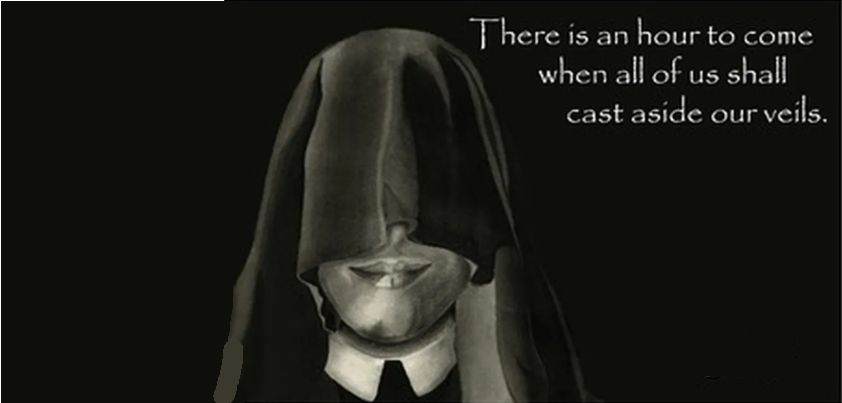 In this Nathaniel Hawthorne story, a church minister frightens and intrigues parishioners by spending most of his life hiding his face behind a black veil. themes include uncertainty (Why the veil?), alienation and loneliness, hidden sins (for which the veil may be a symbol), moral superiority, guilt, fear, and death. Most readers consider the story from the parishioner’s side. However, it is interesting to contemplate how dark the world must look to the minister. Is the veil the equivalent of the dream by a character in another Hawthorne story (Young Goodman Brown): a reminder of the evil in every man? More…
In this Nathaniel Hawthorne story, a church minister frightens and intrigues parishioners by spending most of his life hiding his face behind a black veil. themes include uncertainty (Why the veil?), alienation and loneliness, hidden sins (for which the veil may be a symbol), moral superiority, guilt, fear, and death. Most readers consider the story from the parishioner’s side. However, it is interesting to contemplate how dark the world must look to the minister. Is the veil the equivalent of the dream by a character in another Hawthorne story (Young Goodman Brown): a reminder of the evil in every man? More…
The White Horses of Vienna
 This story from Kay Boyle reflects the rise of Austrian Nazism in the early 1930s. Its main characters are an injured doctor (and Nazi sympathizer), his anti-Semitic wife, and a Jewish locum sent to work with them. The story neither condemns nor condones Nazism. A puppet show alludes to the injured doctor’s political ideals; a tale about Vienna’s famed Lipizzaner horses is a metaphor for the fall of the Austrian Empire and the dire economic circumstances that will soon encourage the government to welcome Hitler’s armies. Themes include isolation and natural beauty, family, racism, fascism, activism vs. acceptance. More…
This story from Kay Boyle reflects the rise of Austrian Nazism in the early 1930s. Its main characters are an injured doctor (and Nazi sympathizer), his anti-Semitic wife, and a Jewish locum sent to work with them. The story neither condemns nor condones Nazism. A puppet show alludes to the injured doctor’s political ideals; a tale about Vienna’s famed Lipizzaner horses is a metaphor for the fall of the Austrian Empire and the dire economic circumstances that will soon encourage the government to welcome Hitler’s armies. Themes include isolation and natural beauty, family, racism, fascism, activism vs. acceptance. More…
God Sees the Truth, But Waits
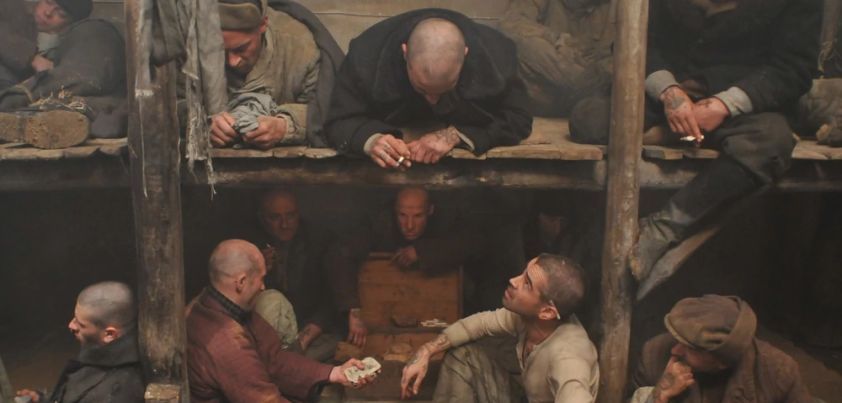 This is one of Leo Tolstoy’s earlier short stories, published between his two epic novels War and Peace and Anna Karenina, and thirteen years before What Men Live By. It has themes of injustice, acceptance, forgiveness and redemption. The protagonist suffers a dramatic fall in worldly terms, which is more than matched by his growth in spiritual grace. The plot was not new. It is a re-working of an almost identical tale from War and Peace related by peasant character Platon Karataev. The novel was written for the Russian nobility; this version was targeted at its common people. More…
This is one of Leo Tolstoy’s earlier short stories, published between his two epic novels War and Peace and Anna Karenina, and thirteen years before What Men Live By. It has themes of injustice, acceptance, forgiveness and redemption. The protagonist suffers a dramatic fall in worldly terms, which is more than matched by his growth in spiritual grace. The plot was not new. It is a re-working of an almost identical tale from War and Peace related by peasant character Platon Karataev. The novel was written for the Russian nobility; this version was targeted at its common people. More…
One Ordinary Day, With Peanuts
 The protagonist in this story from Shirley Jackson initially appears too good to be true. A seemingly ordinary man fills his pockets with candy and peanuts and walks the streets of New York, helping strangers and acting “Mr. Nice Guy”. The apparent theme is making a difference… how a good deed, a kind word, or even just a smile can brighten up someone’s day. It is not until we reach the end of the story that we are presented with two other themes: things are not always what they seem, and the duality of good and evil. More…
The protagonist in this story from Shirley Jackson initially appears too good to be true. A seemingly ordinary man fills his pockets with candy and peanuts and walks the streets of New York, helping strangers and acting “Mr. Nice Guy”. The apparent theme is making a difference… how a good deed, a kind word, or even just a smile can brighten up someone’s day. It is not until we reach the end of the story that we are presented with two other themes: things are not always what they seem, and the duality of good and evil. More…
The Snob
 In this story by Morley Callaghan, a young man shopping with a new girlfriend shames his poorly dressed father by not acknowledging him when they find themselves close to each other in a department store. The girl’s family are more affluent and sophisticated than his, and he is self-conscious about the difference. Ironically, although he is guilty of snobbery in ignoring his father, his anger at himself over having done so causes him to lose his temper and wrongfully accuse the girl of being a snob. Themes include identity, class, judgement by appearances, shame, guilt, hypocrisy. More…
In this story by Morley Callaghan, a young man shopping with a new girlfriend shames his poorly dressed father by not acknowledging him when they find themselves close to each other in a department store. The girl’s family are more affluent and sophisticated than his, and he is self-conscious about the difference. Ironically, although he is guilty of snobbery in ignoring his father, his anger at himself over having done so causes him to lose his temper and wrongfully accuse the girl of being a snob. Themes include identity, class, judgement by appearances, shame, guilt, hypocrisy. More…
A Great Day
 An unusual aspect of this story from Frank Sargeson is that it is largely made up of superficial conversations between two ‘friends’ out in a boat for a morning fishing trip. Readers are given sufficient clues to piece together the men’s backgrounds and the major issues between them. However, they must make their own judgements about the grim climax. An important question in assessing Fred’s character is the timing of his plan. Was it a callous, premeditated decision made before the “Great Day”, or a spur of the moment, opportunistic idea? Themes: envy, jealousy, class, self-esteem, masculinity. More…
An unusual aspect of this story from Frank Sargeson is that it is largely made up of superficial conversations between two ‘friends’ out in a boat for a morning fishing trip. Readers are given sufficient clues to piece together the men’s backgrounds and the major issues between them. However, they must make their own judgements about the grim climax. An important question in assessing Fred’s character is the timing of his plan. Was it a callous, premeditated decision made before the “Great Day”, or a spur of the moment, opportunistic idea? Themes: envy, jealousy, class, self-esteem, masculinity. More…
Hominids
 In this story by Jill McCorkle, a woman hosting a dinner party for a group of her husband’s old friends is disgusted by the way the men joke about the bodies of women they had encountered at a strip club earlier in the day. She muses about modern man’s obsession with breasts, and the contrast between the privileged life of the wives present and the circumstances that might lead other women to take up such work. She confronts the men, along the way cynically threatening to open her own club called “Peckers”. Themes include machismo, sexualization, misogyny, beauty and womanhood. More…
In this story by Jill McCorkle, a woman hosting a dinner party for a group of her husband’s old friends is disgusted by the way the men joke about the bodies of women they had encountered at a strip club earlier in the day. She muses about modern man’s obsession with breasts, and the contrast between the privileged life of the wives present and the circumstances that might lead other women to take up such work. She confronts the men, along the way cynically threatening to open her own club called “Peckers”. Themes include machismo, sexualization, misogyny, beauty and womanhood. More…
The Man Who Was Almost a Man
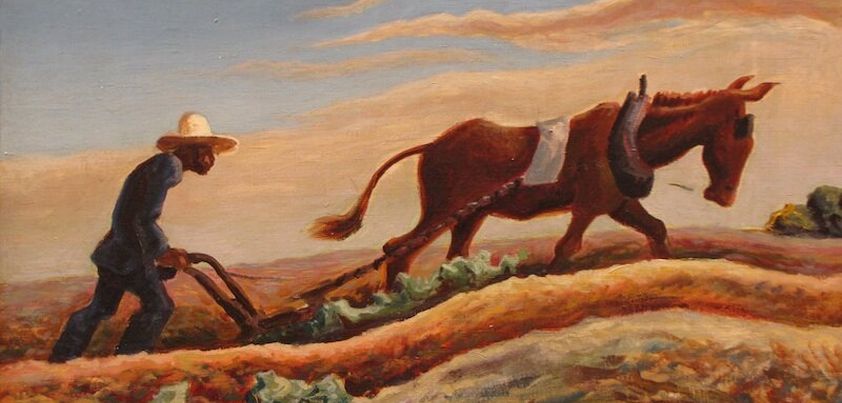 At seventeen, Richard Wright’s naïve protagonist (Dave) is old enough and strong enough to do a man’s work. Unfortunately, his family and co-workers treat him like a boy. Dave buys a gun, believing that having one will win him the respect he deserves. Instead, a wayward shot when he first uses it brings humiliation. Despite the accident, the gun gives Dave a sense of power. Faced with losing it and resuming his former life, he leaves town to look for somewhere a seventeen-year-old with a gun can be a man. Themes: class/racism, coming of age, respect, rebellion, the gun debate. More…
At seventeen, Richard Wright’s naïve protagonist (Dave) is old enough and strong enough to do a man’s work. Unfortunately, his family and co-workers treat him like a boy. Dave buys a gun, believing that having one will win him the respect he deserves. Instead, a wayward shot when he first uses it brings humiliation. Despite the accident, the gun gives Dave a sense of power. Faced with losing it and resuming his former life, he leaves town to look for somewhere a seventeen-year-old with a gun can be a man. Themes: class/racism, coming of age, respect, rebellion, the gun debate. More…
The American Embassy
 Set following Nigeria’s 1993 military coup, this Chimamanda Adichie story includes themes of corruption, civil unrest and army brutality. The protagonist has a seemingly perfect case for U.S. asylum. Her anti-government journalist husband has already fled to America, and some troops searching for him accidentally shot their four-year-old son. Yet mid-way through the visa interview, she decides not to continue. The shooting has caused her to question their future together. This introduces two additional themes: the strong ties Africans have to their roots, and the importance of traditions… in this case the need for someone to tend the boy’s grave. More…
Set following Nigeria’s 1993 military coup, this Chimamanda Adichie story includes themes of corruption, civil unrest and army brutality. The protagonist has a seemingly perfect case for U.S. asylum. Her anti-government journalist husband has already fled to America, and some troops searching for him accidentally shot their four-year-old son. Yet mid-way through the visa interview, she decides not to continue. The shooting has caused her to question their future together. This introduces two additional themes: the strong ties Africans have to their roots, and the importance of traditions… in this case the need for someone to tend the boy’s grave. More…
Dry September
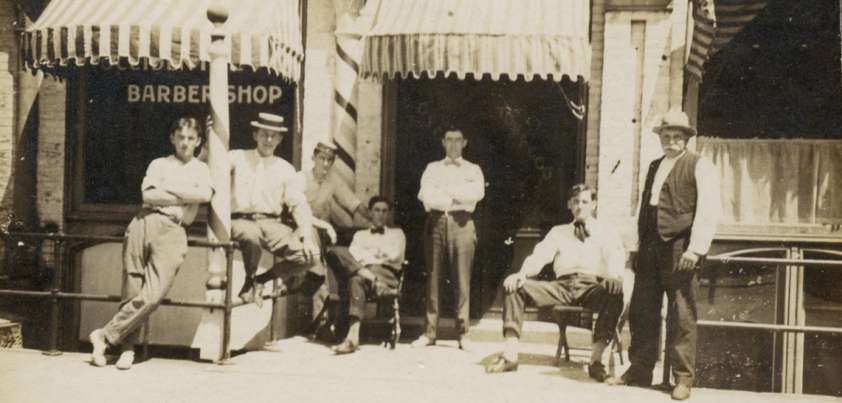 William Faulkner’s Dry September deals with events leading up to and shortly after the vigilante murder of a presumably innocent man. Set in a racially prejudiced community in America’s South, a misplaced or malicious complaint from a middle-aged spinster incites hatred against a local negro. Only one man (the town barber) stands up for him. A decorated ex-soldier leads a mob to avenge the woman’s honor. After the killing, the reliability of the woman’s story is called into question, as is the mental condition of the soldier who is shown to be violent by nature and possibly suffering from PTSD. More…
William Faulkner’s Dry September deals with events leading up to and shortly after the vigilante murder of a presumably innocent man. Set in a racially prejudiced community in America’s South, a misplaced or malicious complaint from a middle-aged spinster incites hatred against a local negro. Only one man (the town barber) stands up for him. A decorated ex-soldier leads a mob to avenge the woman’s honor. After the killing, the reliability of the woman’s story is called into question, as is the mental condition of the soldier who is shown to be violent by nature and possibly suffering from PTSD. More…
Evening Primrose
 It is always nice to find a story with a quirky, innovative storyline. John Collier’s Evening Primrose is in the form of a journal describing the experiences of a failed poet who gives up the outside world to spend the rest of his life living in a department store. He plans to hide out by day and wander the store at night collecting food and other necessities. To his surprise, he finds that a small community of like-minded people already inhabit the store. The only things they fear are discovery by the night watchman and the gruesome “Dark Men.” More…
It is always nice to find a story with a quirky, innovative storyline. John Collier’s Evening Primrose is in the form of a journal describing the experiences of a failed poet who gives up the outside world to spend the rest of his life living in a department store. He plans to hide out by day and wander the store at night collecting food and other necessities. To his surprise, he finds that a small community of like-minded people already inhabit the store. The only things they fear are discovery by the night watchman and the gruesome “Dark Men.” More…
Prayer for the Living
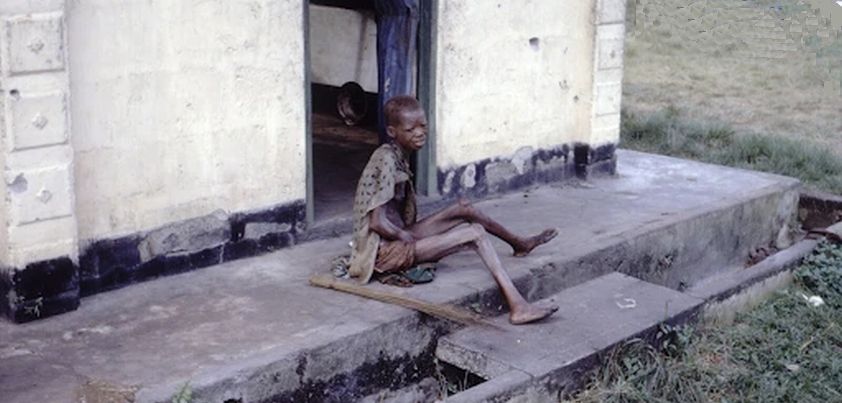 This story by Ben Okri highlights the suffering of innocent civilians caught up in regional conflicts. Set during the Nigerian Civil War when a government blockade of the self-proclaimed Republic of Biafra resulted in mass starvation, a man who hasn’t eaten for three weeks walks among corpses scattered in an unnamed town. He has come to the grim conclusion that the dead seem happier and more alive than the living. His purpose… to make sure that his family and lover are dead before finding “happiness” himself. Themes include the horrors of war, corruption/ethnic rivalry, suffering, acceptance, death as relief. More…
This story by Ben Okri highlights the suffering of innocent civilians caught up in regional conflicts. Set during the Nigerian Civil War when a government blockade of the self-proclaimed Republic of Biafra resulted in mass starvation, a man who hasn’t eaten for three weeks walks among corpses scattered in an unnamed town. He has come to the grim conclusion that the dead seem happier and more alive than the living. His purpose… to make sure that his family and lover are dead before finding “happiness” himself. Themes include the horrors of war, corruption/ethnic rivalry, suffering, acceptance, death as relief. More…
Everyday Use
 Alice Walker’s study of mother-daughter relationships explores contrasting attitudes towards heritage. A self-centered college graduate (Dee) visits her mother, a poor farming widow. The mother values her African-American heritage; Dee tries to exploit it. Their positions are exemplified in a family heirloom: a hand-stitched quilt that has been promised to Dee’s sister. Dee demands it, claiming that such things are now trendy and valuable. She claims it will be wasted on her sister, who will probably put it to “everyday use”. Themes: heritage, racial identity, connection through tradition, appearance, materialism (the effect of higher education / city life on values). More…
Alice Walker’s study of mother-daughter relationships explores contrasting attitudes towards heritage. A self-centered college graduate (Dee) visits her mother, a poor farming widow. The mother values her African-American heritage; Dee tries to exploit it. Their positions are exemplified in a family heirloom: a hand-stitched quilt that has been promised to Dee’s sister. Dee demands it, claiming that such things are now trendy and valuable. She claims it will be wasted on her sister, who will probably put it to “everyday use”. Themes: heritage, racial identity, connection through tradition, appearance, materialism (the effect of higher education / city life on values). More…
The Pardon of Becky Day
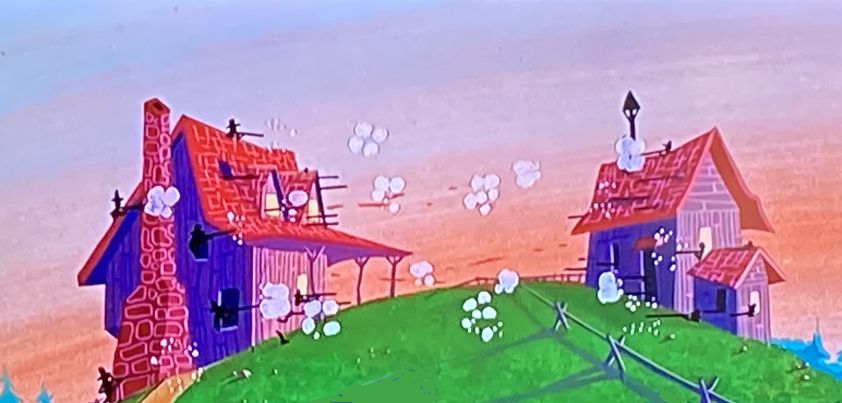 A motif of this classic Western by John Fox, Jr. could well be the scheming nature of women. A neighbor misled the community as to Becky’s virtue to win her boyfriend Jim’s heart; both women manipulate the men around them to maintain their “honor”; a missionary uses the threat of a deathbed curse to force the reluctant neighbor to seek Becky’s forgiveness; and, based on the smile on Becky’s face when she dies, her words of forgiveness may have been feigned to make sure that she will “git thar” [where Jim is] first. Themes: deception, hate, lawless violence, forgiveness, superstition. More…
A motif of this classic Western by John Fox, Jr. could well be the scheming nature of women. A neighbor misled the community as to Becky’s virtue to win her boyfriend Jim’s heart; both women manipulate the men around them to maintain their “honor”; a missionary uses the threat of a deathbed curse to force the reluctant neighbor to seek Becky’s forgiveness; and, based on the smile on Becky’s face when she dies, her words of forgiveness may have been feigned to make sure that she will “git thar” [where Jim is] first. Themes: deception, hate, lawless violence, forgiveness, superstition. More…
The Imitation of the Rose
 If you are looking for a light read, this story by Clarice Lispector is not for you! The protagonist (Laura) has just come home from hospital following a nervous breakdown. Her husband has expectations about a having a “normal” night out together with friends. The story has little more by way of plot, taking place mostly in Laura’s mind. The main themes are mental health, gender identity and family roles. By nature a submissive and withdrawn person, Laura is successfully adjusting to life back at home. Unfortunately, deciding on what to do with a bunch of roses rekindles her anxiety. More…
If you are looking for a light read, this story by Clarice Lispector is not for you! The protagonist (Laura) has just come home from hospital following a nervous breakdown. Her husband has expectations about a having a “normal” night out together with friends. The story has little more by way of plot, taking place mostly in Laura’s mind. The main themes are mental health, gender identity and family roles. By nature a submissive and withdrawn person, Laura is successfully adjusting to life back at home. Unfortunately, deciding on what to do with a bunch of roses rekindles her anxiety. More…
An Upheaval
 Major themes of his story by Anton Chekhov include social class, pride, respect, dignity and courage. A young woman in her first job as a governess returns from a walk to find the woman of the house searching her room for a missing brooch. She is so offended and incensed that, despite entreaties by the woman’s husband, she decides to leave. An unusual (for Chekhov) aspect of the story is that here we have a relatively powerless woman stand up to the humiliating treatment of her aristocratic employer, even though it may cost her and her parents dearly. More…
Major themes of his story by Anton Chekhov include social class, pride, respect, dignity and courage. A young woman in her first job as a governess returns from a walk to find the woman of the house searching her room for a missing brooch. She is so offended and incensed that, despite entreaties by the woman’s husband, she decides to leave. An unusual (for Chekhov) aspect of the story is that here we have a relatively powerless woman stand up to the humiliating treatment of her aristocratic employer, even though it may cost her and her parents dearly. More…
The Son from America
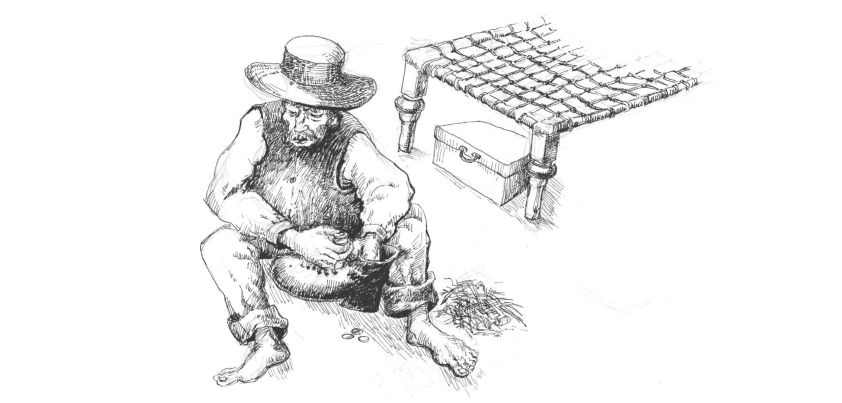 The major theme of this moving story by Isaac Singer is contentment. Set in a Polish farming village during the late 19th century, an old couple eke out a meager existence following their traditional way of life. Hidden away in their hut is a small fortune, saved from money sent over the years by their son in America. When the son visits with plans to provide further help and improve the amenities of the village, his offers are rejected. Additional themes: family, materialiam (money vs. happiness), religious faith, community spirit, change (urbanization, invention), pace of life (city vs. country). More…
The major theme of this moving story by Isaac Singer is contentment. Set in a Polish farming village during the late 19th century, an old couple eke out a meager existence following their traditional way of life. Hidden away in their hut is a small fortune, saved from money sent over the years by their son in America. When the son visits with plans to provide further help and improve the amenities of the village, his offers are rejected. Additional themes: family, materialiam (money vs. happiness), religious faith, community spirit, change (urbanization, invention), pace of life (city vs. country). More…
Knock
 This story by Fredric Brown begins and ends with what may be the shortest horror story ever written: The last man on Earth sat alone in a room. There was a knock on the door… A scientist wakes to find himself alone in a cell. The previous night Alien invaders had collected 217 animal species, including him, for study. They then destroyed all other animal life on the planet. He convinces them that Earth is a dangerous place to live. After they have gone, he hears the second knock on the door. Themes include exploration, genocide, deceit, solitude, “duty”. More…
This story by Fredric Brown begins and ends with what may be the shortest horror story ever written: The last man on Earth sat alone in a room. There was a knock on the door… A scientist wakes to find himself alone in a cell. The previous night Alien invaders had collected 217 animal species, including him, for study. They then destroyed all other animal life on the planet. He convinces them that Earth is a dangerous place to live. After they have gone, he hears the second knock on the door. Themes include exploration, genocide, deceit, solitude, “duty”. More…
The Faith Cure Man
 In this story from Paul Dunbar, a faith healer provides the last hope for a desperate woman who has been told that medical science can do nothing more for her seriously ill daughter. Despite the narrator’s skepticism, the tragic ending neither proves nor disproves the validity of faith healing. Although the mother certainly has the “faith”, the poor child is too young and/or sick to understand or even care about what is happening around her. The major theme of the story is that distraught people are easy prey to those offering false hope. Other themes: love, desperation, hope, faith, death. More…
In this story from Paul Dunbar, a faith healer provides the last hope for a desperate woman who has been told that medical science can do nothing more for her seriously ill daughter. Despite the narrator’s skepticism, the tragic ending neither proves nor disproves the validity of faith healing. Although the mother certainly has the “faith”, the poor child is too young and/or sick to understand or even care about what is happening around her. The major theme of the story is that distraught people are easy prey to those offering false hope. Other themes: love, desperation, hope, faith, death. More…
The District Doctor
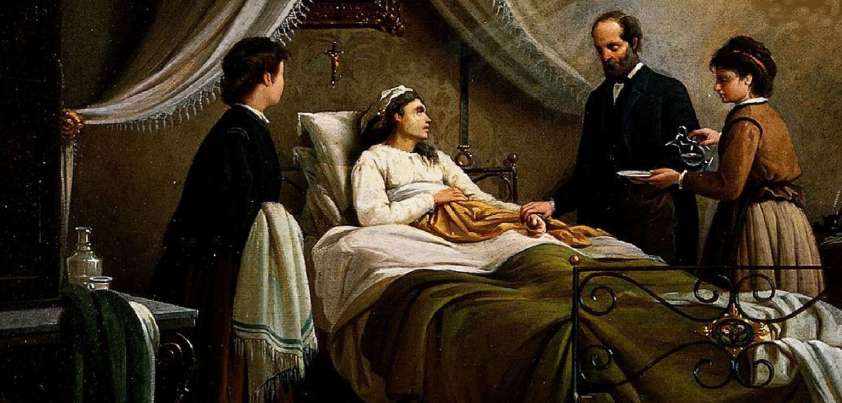 The major themes of this story by Ivan Turgenev are duty, lying, love, death and betrayal. A doctor becomes infatuated with a beautiful 20-year-old patient. As the woman’s condition worsens, he lies to her family about her chances of recovery. On sensing her coming death, the woman tells the doctor she loves him. He replies that he also loves her, accepts her ring, and promises to ask for her mother’s blessing. When the woman confesses their love to her mother, the doctor denies everything and blames her fever. Broken-hearted, she for asks his forgiveness and re-affirms her love before dying. More…
The major themes of this story by Ivan Turgenev are duty, lying, love, death and betrayal. A doctor becomes infatuated with a beautiful 20-year-old patient. As the woman’s condition worsens, he lies to her family about her chances of recovery. On sensing her coming death, the woman tells the doctor she loves him. He replies that he also loves her, accepts her ring, and promises to ask for her mother’s blessing. When the woman confesses their love to her mother, the doctor denies everything and blames her fever. Broken-hearted, she for asks his forgiveness and re-affirms her love before dying. More…
Seventh Day of the Seventh Moon
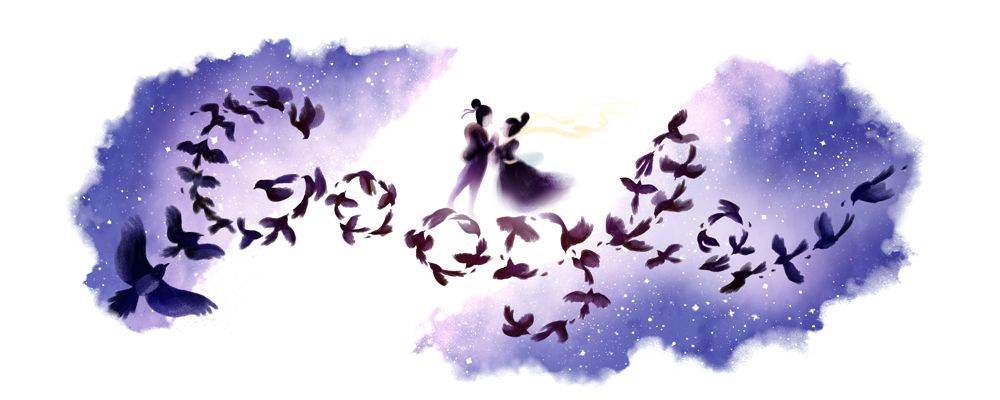 In this bittersweet story by Ken Liu, the myth behind China’s annual Qixi Festival comes to life to help two young women in love face a forced separation. On the eve before parting, flocks of magpies magically appear to transport them to the ‘bridge’ upon which the Qixi lovers meet once a year. The message they receive from the mythical couple is that if one loves someone and moves on, their love remains true no matter how many times they fall in love with others. Themes include culture, tradition, change (Westernization/commercialism), love, separation, moving on, sexuality, the supernatural. More…
In this bittersweet story by Ken Liu, the myth behind China’s annual Qixi Festival comes to life to help two young women in love face a forced separation. On the eve before parting, flocks of magpies magically appear to transport them to the ‘bridge’ upon which the Qixi lovers meet once a year. The message they receive from the mythical couple is that if one loves someone and moves on, their love remains true no matter how many times they fall in love with others. Themes include culture, tradition, change (Westernization/commercialism), love, separation, moving on, sexuality, the supernatural. More…
Chivalry
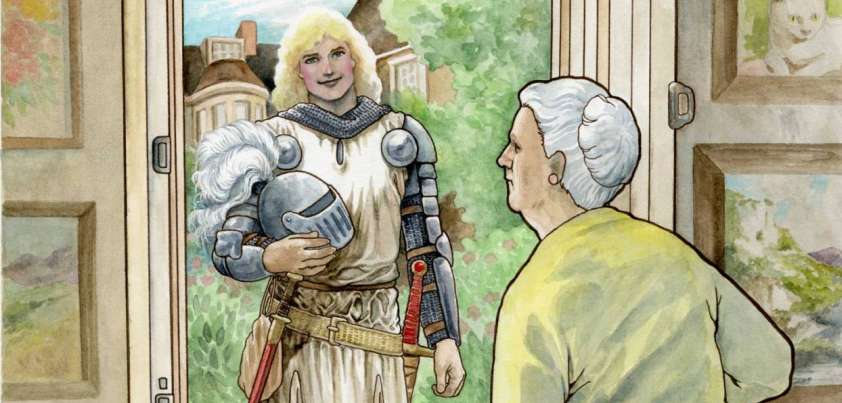 This Neil Gaiman fantasy features a nice old lady with nice friends, who lives in a nice house in a nice neighborhood. She was also living a nice, peaceful life until one day her routine was interrupted by Sir Galahad on a quest to find the Holy Grail. Having recently bought the Grail at an op-shop, the woman refuses Galahad’s offers of the Sword of Invincibility and Apple of (eternal) Life in exchange. Fortunately, the lad finds two other items she thinks would look better on the mantelpiece. Themes include civility and respect, patience, perseverance, and contentment in old age. More…
This Neil Gaiman fantasy features a nice old lady with nice friends, who lives in a nice house in a nice neighborhood. She was also living a nice, peaceful life until one day her routine was interrupted by Sir Galahad on a quest to find the Holy Grail. Having recently bought the Grail at an op-shop, the woman refuses Galahad’s offers of the Sword of Invincibility and Apple of (eternal) Life in exchange. Fortunately, the lad finds two other items she thinks would look better on the mantelpiece. Themes include civility and respect, patience, perseverance, and contentment in old age. More…
The Fence
 This story from Hamsad Rangkuti is an allegory of the biblical concept do unto others as you would have them do unto you. Many people are uncomfortable interacting with those who are different or less fortunate. Their solution is to establish social boundaries (fences) that block concerns about them from their lives. The story’s message is two-fold. First, no fence offers complete protection. Second, as exemplified by the vagrant gang, the mere existence of such a fence can bring about the result it is intended to prevent. Themes: (the mother) fear, lack of compassion, selfishness; (the father) kindness, sharing, faith. More…
This story from Hamsad Rangkuti is an allegory of the biblical concept do unto others as you would have them do unto you. Many people are uncomfortable interacting with those who are different or less fortunate. Their solution is to establish social boundaries (fences) that block concerns about them from their lives. The story’s message is two-fold. First, no fence offers complete protection. Second, as exemplified by the vagrant gang, the mere existence of such a fence can bring about the result it is intended to prevent. Themes: (the mother) fear, lack of compassion, selfishness; (the father) kindness, sharing, faith. More…
Button, Button
 Major themes of of Richard Matheson’s Button, Button are greed and morality. A couple argue over whether to press a button in a mysterious box. Doing so will earn them $50,000, but it will also trigger the death of a stranger. One seems OK with it, provided the victim was someone they couldn’t possibly know. The other disagrees, arguing it would still be a form of murder. Their discussion suggests the story may be an allegory. Pressing a button to launch a missile and dealing in commercial quantities of drugs have one thing in common: the victims are all faceless strangers. More…
Major themes of of Richard Matheson’s Button, Button are greed and morality. A couple argue over whether to press a button in a mysterious box. Doing so will earn them $50,000, but it will also trigger the death of a stranger. One seems OK with it, provided the victim was someone they couldn’t possibly know. The other disagrees, arguing it would still be a form of murder. Their discussion suggests the story may be an allegory. Pressing a button to launch a missile and dealing in commercial quantities of drugs have one thing in common: the victims are all faceless strangers. More…
Some Families, Very Large
 Central themes of this “Christmas Offering” by Jose Dalisay Jr. are the unconditional love and acceptance of obvious flaws that young children exhibit for their parents, and the bitterness of grief when there is no one with whom to share it. It is Christmas, but nine-year-old Sammy’s con-man father is more interested in gambling than celebrating it with him. Later a grieving mother, desperate for company, welcomes them both into her “family”. The Christmas message of the story (hope!) comes as the three close their eyes and imagine a better life. Other themes include childhood innocence, poverty, loss, responsibility. More…
Central themes of this “Christmas Offering” by Jose Dalisay Jr. are the unconditional love and acceptance of obvious flaws that young children exhibit for their parents, and the bitterness of grief when there is no one with whom to share it. It is Christmas, but nine-year-old Sammy’s con-man father is more interested in gambling than celebrating it with him. Later a grieving mother, desperate for company, welcomes them both into her “family”. The Christmas message of the story (hope!) comes as the three close their eyes and imagine a better life. Other themes include childhood innocence, poverty, loss, responsibility. More…
The Street-sweeping Show
 This story by Feng Jicai provides an insight as to how Chinese bureaucracy functioned under the Mao regime. A town Mayor, surrounded by groveling officials, puts on an artificial media show to be seen supporting National Cleanup Week. The event needs no publicity, as the town’s population is already out sweeping the streets. Moreover, the carefully choreographed newspaper and T.V. shoot is held in the Central Square, which has already been swept clean. When the Mayor’s grandson points out that he is on TV, he comments: It’s not worth watching! Themes include social class, propaganda, media manipulation, appearance vs. reality. More…
This story by Feng Jicai provides an insight as to how Chinese bureaucracy functioned under the Mao regime. A town Mayor, surrounded by groveling officials, puts on an artificial media show to be seen supporting National Cleanup Week. The event needs no publicity, as the town’s population is already out sweeping the streets. Moreover, the carefully choreographed newspaper and T.V. shoot is held in the Central Square, which has already been swept clean. When the Mayor’s grandson points out that he is on TV, he comments: It’s not worth watching! Themes include social class, propaganda, media manipulation, appearance vs. reality. More…
The Star
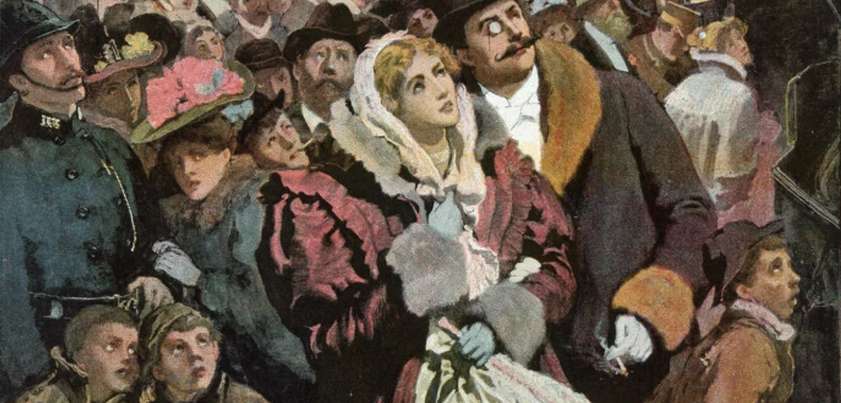 This apocalyptic story from H. G. Wells describes a near miss of Earth by a huge planetary fragment from outside the solar system. A somewhat disheartening theme is how insignificant the human race and its achievements are in the grand scheme of the universe. Part of the story’s appeal lies in questioning whether people would respond in a similar way if the same thing were to happen today. At first, people view the new “star” with excitement and anticipation. When a master mathematician makes dire predictions, many flee their cities in panic. But surprisingly, most do nothing until too late. More…
This apocalyptic story from H. G. Wells describes a near miss of Earth by a huge planetary fragment from outside the solar system. A somewhat disheartening theme is how insignificant the human race and its achievements are in the grand scheme of the universe. Part of the story’s appeal lies in questioning whether people would respond in a similar way if the same thing were to happen today. At first, people view the new “star” with excitement and anticipation. When a master mathematician makes dire predictions, many flee their cities in panic. But surprisingly, most do nothing until too late. More…
Average Waves in Unprotected Waters
 The ironic title of this story from Anne Tyler is said to be symbolic of protagonist Bet’s life. Like her fisherman father, Bet faces “average waves” (life challenges) in “unprotected waters” (alone). All her life, Bet has allowed herself to be battered by the waves, taking comfort from enduring. Unfortunately, the major challenge she has faced, raising a special needs son, is far from average. Her courageous decision to institutionalize Arnold suggests an attempt to take control of her life, but leaves her feeling empty and even more alone. Themes: memory, family, life-changing choices, motherly love, identity, courage, self-determination. More…
The ironic title of this story from Anne Tyler is said to be symbolic of protagonist Bet’s life. Like her fisherman father, Bet faces “average waves” (life challenges) in “unprotected waters” (alone). All her life, Bet has allowed herself to be battered by the waves, taking comfort from enduring. Unfortunately, the major challenge she has faced, raising a special needs son, is far from average. Her courageous decision to institutionalize Arnold suggests an attempt to take control of her life, but leaves her feeling empty and even more alone. Themes: memory, family, life-changing choices, motherly love, identity, courage, self-determination. More…
Foreign Shores
 A feature of this story from James Salter is its ambiguity, starting with the identity of the protagonist. Is it Gloria, the young divorcee who is too caught-up in partying to take proper care of her demanding six-year-old-son? Or is it Truus, her conscientious nineteen-year-old au pair? And although Truss is certainly the erotic focus of the story, does she really develop the morals of a housefly? Alternatively, could she an exploited victim, guilty only of misguided love, or is everything an unfortunate misunderstanding? Themes: sexual grooming / exploitation, appearance, motherhood, condescension, judgmentalism, jealousy, insecurity, emptiness. More…
A feature of this story from James Salter is its ambiguity, starting with the identity of the protagonist. Is it Gloria, the young divorcee who is too caught-up in partying to take proper care of her demanding six-year-old-son? Or is it Truus, her conscientious nineteen-year-old au pair? And although Truss is certainly the erotic focus of the story, does she really develop the morals of a housefly? Alternatively, could she an exploited victim, guilty only of misguided love, or is everything an unfortunate misunderstanding? Themes: sexual grooming / exploitation, appearance, motherhood, condescension, judgmentalism, jealousy, insecurity, emptiness. More…
Story in a Mirror
 In this intriguing story by Ilse Aichinger, a woman’s life “flashes before her eyes” as she dies in hospital from an infection following an illegal abortion. During her death struggle she looks forward, picturing her burial, and then travells backward in time, re-living key events all the way back to her birth. An interesting concept is that the journey brings redemption… In the mirror one does everything so that it may be forgiven. For example, it becomes clear that she didn’t want the abortion, but rather was ordered to by her controlling lover. Themes include, death, time, memories, regret, redemption. More…
In this intriguing story by Ilse Aichinger, a woman’s life “flashes before her eyes” as she dies in hospital from an infection following an illegal abortion. During her death struggle she looks forward, picturing her burial, and then travells backward in time, re-living key events all the way back to her birth. An interesting concept is that the journey brings redemption… In the mirror one does everything so that it may be forgiven. For example, it becomes clear that she didn’t want the abortion, but rather was ordered to by her controlling lover. Themes include, death, time, memories, regret, redemption. More…
The Golden Honeymoon
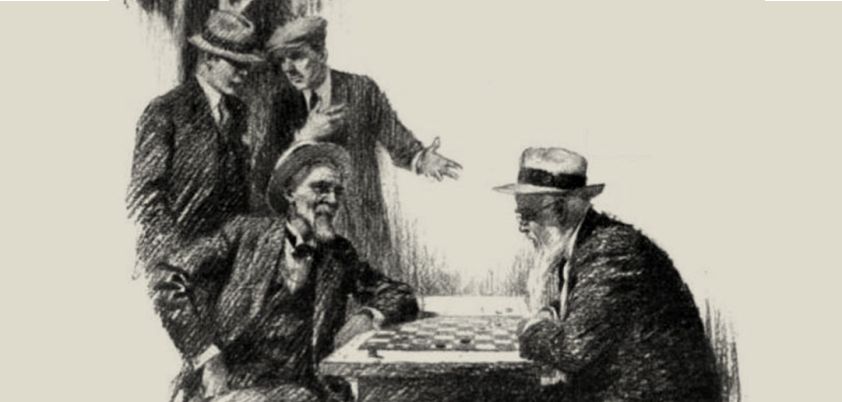 This story from Ring Lardner describes an elderly couple’s “second honeymoon” to celebrate their 50th (golden) wedding anniversary. Related in the folksy language of the 1920s, the story is a gentle satire of the shallow lives and petty concerns of the aged, and the way long-term marriages can evolve into lives of constant, albeit affectionate, bickering. Larder’s narrator (the husband) is a likeable old windbag: vain and insensitive; a good winner but poor loser; quick to find fault in others but never in himself; and always wanting things to go his way. Themes: aging, enduring love, jealousy, competitiveness, pettiness. More…
This story from Ring Lardner describes an elderly couple’s “second honeymoon” to celebrate their 50th (golden) wedding anniversary. Related in the folksy language of the 1920s, the story is a gentle satire of the shallow lives and petty concerns of the aged, and the way long-term marriages can evolve into lives of constant, albeit affectionate, bickering. Larder’s narrator (the husband) is a likeable old windbag: vain and insensitive; a good winner but poor loser; quick to find fault in others but never in himself; and always wanting things to go his way. Themes: aging, enduring love, jealousy, competitiveness, pettiness. More…
Rothschild’s Fiddle (Violin)
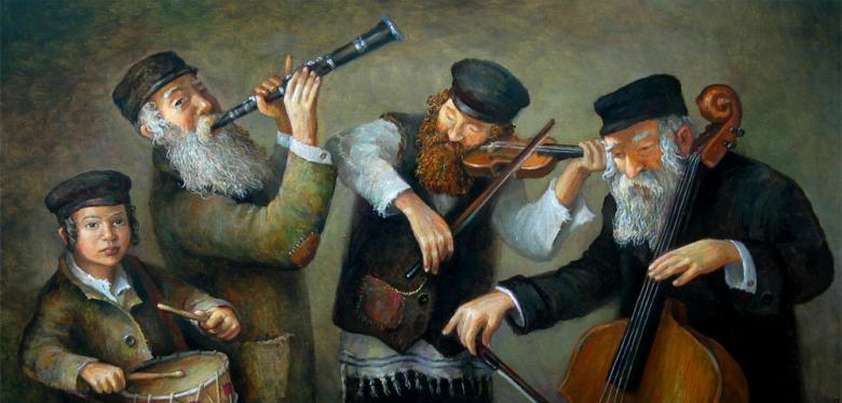 Many of Anton Chekhov’s stories deal with the struggles of the Russian working class. Some, like The Looking Glass and Misery, are quite depressing. This story, which deals with the themes of greed, prejudice and death, includes elements of dark humour and ends on a positive note. Yakov the coffin-builder measures his success by missed moneymaking opportunities. His only happiness is his violin, which he plays in a village band. When his wife dies, he regrets not having done more to enjoy life. He makes some amends on his deathbed by leaving his violin to a most unlikely person. More…
Many of Anton Chekhov’s stories deal with the struggles of the Russian working class. Some, like The Looking Glass and Misery, are quite depressing. This story, which deals with the themes of greed, prejudice and death, includes elements of dark humour and ends on a positive note. Yakov the coffin-builder measures his success by missed moneymaking opportunities. His only happiness is his violin, which he plays in a village band. When his wife dies, he regrets not having done more to enjoy life. He makes some amends on his deathbed by leaving his violin to a most unlikely person. More…
America and I
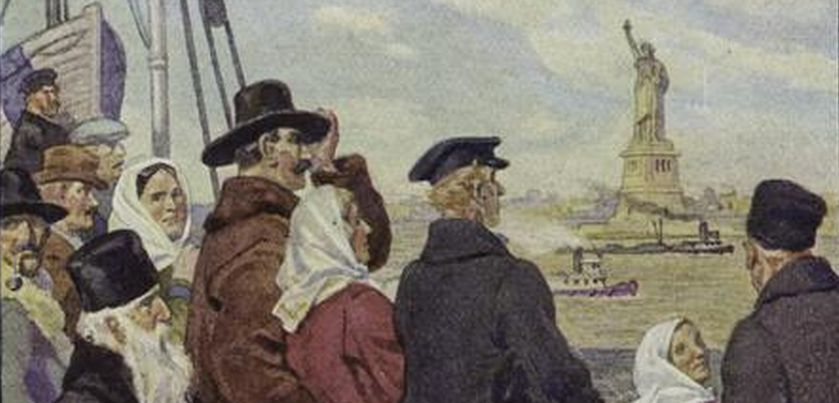 In this semi-autobiographical story, Anzia Yezierska begins by outlining her expectations of life in America as a young Russian immigrant in the late 1800s. Instead of a land of acceptance, equality and opportunity, she experiences alienation, exploitation and poverty. Although her situation improves as she develops English proficiency and vocational skills, her factory job is not satisfying. Fortunately, the study of American history leads to the revelation that her adopted country is a world still in the making, and helps her find a fulfilling purpose in life. Themes include innocence, poverty, immigration and cultural diversity, assimilation, opportunity, fulfilment.
In this semi-autobiographical story, Anzia Yezierska begins by outlining her expectations of life in America as a young Russian immigrant in the late 1800s. Instead of a land of acceptance, equality and opportunity, she experiences alienation, exploitation and poverty. Although her situation improves as she develops English proficiency and vocational skills, her factory job is not satisfying. Fortunately, the study of American history leads to the revelation that her adopted country is a world still in the making, and helps her find a fulfilling purpose in life. Themes include innocence, poverty, immigration and cultural diversity, assimilation, opportunity, fulfilment.
The world, and America’s need for unskilled migrants, has changed. Yezierska laments the fact that America was unable to tap the human and cultural potential of many other immigrants of her day. Sadly, the poor woman would turn in her grave if she knew how far off the mark the idealistic prediction expressed in her last paragraph has proved to be.
Fat
 Few authors could write as powerful a story about a non-PC topic (body shaming) as Raymond Carver has done here. Major themes are the way we judge people, loneliness and choice. A waitress’s co-workers dehumanize a customer by making fun of his size. They have no empathy for the person within. The experience greatly affects the waitress. She is expecting change. Is it leaving her insensitive partner? Could she, as some readers suggest, be pregnant and worried about getting fat herself? Or has she been inspired to face something about herself that she has been too afraid to address before? More…
Few authors could write as powerful a story about a non-PC topic (body shaming) as Raymond Carver has done here. Major themes are the way we judge people, loneliness and choice. A waitress’s co-workers dehumanize a customer by making fun of his size. They have no empathy for the person within. The experience greatly affects the waitress. She is expecting change. Is it leaving her insensitive partner? Could she, as some readers suggest, be pregnant and worried about getting fat herself? Or has she been inspired to face something about herself that she has been too afraid to address before? More…
Cicada
 This coming-of-age story by Camille Acker initially comes across as yet another “too good to be true” tale about a young African-American girl from a working-class family overcoming the odds. (In this case to win a piano competition against privileged white kids from a wealthy neighborhood.) The narrative takes a turn after the competition as her family’s lower socio-economic status becomes clear. Provoked by the rude, condescending attitude of another competitor, she attacks the other girl’s chauffeur-driven car with the only weapon available… cast off cicada shells! Themes include poverty, social class, parental love, success, pride, identity. More…
This coming-of-age story by Camille Acker initially comes across as yet another “too good to be true” tale about a young African-American girl from a working-class family overcoming the odds. (In this case to win a piano competition against privileged white kids from a wealthy neighborhood.) The narrative takes a turn after the competition as her family’s lower socio-economic status becomes clear. Provoked by the rude, condescending attitude of another competitor, she attacks the other girl’s chauffeur-driven car with the only weapon available… cast off cicada shells! Themes include poverty, social class, parental love, success, pride, identity. More…
The Adulterous Woman
 The adultery in this story from Albert Camus is not of the sexual kind. For the married protagonist, the vast expanse of the Algerian desert puts into perspective something she already knew but had refused to face. Although she has a caring and possibly still loving husband, married life has become mundane and, through lack of communication, lonely. With both existentialist and feminist undertones, her epiphany on the rampart provides a brief escape from misery and the realization that life could offer so much more. Themes: lack of fulfillment, loneliness, natural splendor, freedom, finding meaning and purpose in life. More…
The adultery in this story from Albert Camus is not of the sexual kind. For the married protagonist, the vast expanse of the Algerian desert puts into perspective something she already knew but had refused to face. Although she has a caring and possibly still loving husband, married life has become mundane and, through lack of communication, lonely. With both existentialist and feminist undertones, her epiphany on the rampart provides a brief escape from misery and the realization that life could offer so much more. Themes: lack of fulfillment, loneliness, natural splendor, freedom, finding meaning and purpose in life. More…
Quiet Town
 The recently released 6th Assessment Report by the UN Climate Change Panel presents a pessimistic assessment of the world’s progress in controlling global warming. That makes this an appropriate time to feature science fiction writer Jason Gurley’s Quiet Town, a grim picture of what may be the future of low-lying townships along world coastlines. Bev, her son Benji, and annoying neighbor Ezze are among the few remaining residents of a small town in which the rising ocean has just breached the sea wall. Experts had originally predicted that this would not happen for fifty years: it had taken five! More…
The recently released 6th Assessment Report by the UN Climate Change Panel presents a pessimistic assessment of the world’s progress in controlling global warming. That makes this an appropriate time to feature science fiction writer Jason Gurley’s Quiet Town, a grim picture of what may be the future of low-lying townships along world coastlines. Bev, her son Benji, and annoying neighbor Ezze are among the few remaining residents of a small town in which the rising ocean has just breached the sea wall. Experts had originally predicted that this would not happen for fifty years: it had taken five! More…
At War’s End: An Elegy
 This story by Rony V. Diaz takes place during the Philippine Hukbalahap Rebellion at the end of World War 2. The “Huks”, originally a peasant resistance who fought the Japanese, embraced communist principles and turned their attention to overturning the country’s feudal farming system. The heir to a large landholding mysteriously commits suicide. It is unclear whether he acted because of a promise made to break up his family land, or uncertainty and fear about doing so. The answer may lie in a cryptic poem confiscated by police. Major themes include tradition, feudalism, wealth vs. poverty, social change, suicide. More…
This story by Rony V. Diaz takes place during the Philippine Hukbalahap Rebellion at the end of World War 2. The “Huks”, originally a peasant resistance who fought the Japanese, embraced communist principles and turned their attention to overturning the country’s feudal farming system. The heir to a large landholding mysteriously commits suicide. It is unclear whether he acted because of a promise made to break up his family land, or uncertainty and fear about doing so. The answer may lie in a cryptic poem confiscated by police. Major themes include tradition, feudalism, wealth vs. poverty, social change, suicide. More…
Paste
 The main theme of this story from Henry James is that things aren’t always as they appear. The stepson of a deceased vicar’s wife offers her gaudy costume jewellery to his young cousin. Later, the cousin learns that one piece, a pearl necklace, may be genuine. This is one of those rare stories where a protagonist who chooses to do the right thing is the only loser. Mystery surrounds how the dead woman came by such a necklace, and its fate after she returns it. Other themes: temptation, morality, vanity, greed, betrayal. More…
The main theme of this story from Henry James is that things aren’t always as they appear. The stepson of a deceased vicar’s wife offers her gaudy costume jewellery to his young cousin. Later, the cousin learns that one piece, a pearl necklace, may be genuine. This is one of those rare stories where a protagonist who chooses to do the right thing is the only loser. Mystery surrounds how the dead woman came by such a necklace, and its fate after she returns it. Other themes: temptation, morality, vanity, greed, betrayal. More…
Up in Michigan / My Old Man
 Today we have two short stories from Ernest Hemingway’s first book, Three Stories and Ten Poems, published in Paris in 1923. Although they don’t exhibit the tight, straightforward writing style for which Hemingway later became famous, they are indicative of the writing genius to come. The first, Up in Michigan, issues a grim warning to women about date rape. The subject matter was so contentious that it wasn’t considered publishable in the United States until 1938. The second story, My Old Man, is a coming of age story dealing with a boy’s relationship with his jockey father. More…
Today we have two short stories from Ernest Hemingway’s first book, Three Stories and Ten Poems, published in Paris in 1923. Although they don’t exhibit the tight, straightforward writing style for which Hemingway later became famous, they are indicative of the writing genius to come. The first, Up in Michigan, issues a grim warning to women about date rape. The subject matter was so contentious that it wasn’t considered publishable in the United States until 1938. The second story, My Old Man, is a coming of age story dealing with a boy’s relationship with his jockey father. More…
Titanic Survivors Found in Bermuda Triangle
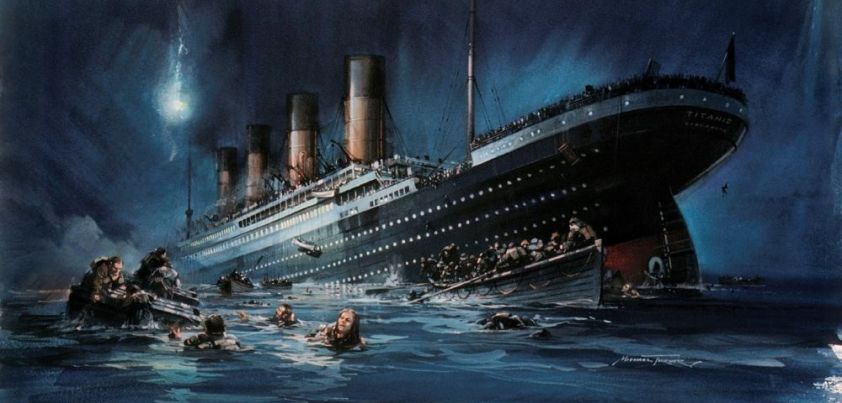 Robert Olen Butler’s Titanic survivor is an early 1900s women’s suffrage campaigner. After “waking up” in a lifeboat off the Miami coast in the 1990s, she realizes there is no place for her in the modern world. Women have been emancipated, and her family and friends are all dead. The only man she has ever had strong feelings for (other than her father) went down with the ship. Having lacked the courage to express her feelings at the time, she decides to find him again. Themes: change, father-daughter relationships, women’s rights, finding purpose and meaning in life, sexuality, misandry, love. More…
Robert Olen Butler’s Titanic survivor is an early 1900s women’s suffrage campaigner. After “waking up” in a lifeboat off the Miami coast in the 1990s, she realizes there is no place for her in the modern world. Women have been emancipated, and her family and friends are all dead. The only man she has ever had strong feelings for (other than her father) went down with the ship. Having lacked the courage to express her feelings at the time, she decides to find him again. Themes: change, father-daughter relationships, women’s rights, finding purpose and meaning in life, sexuality, misandry, love. More…
A Shinagawa Monkey / Confessions of a Shinagawa Monkey
 Last year (2020) Haruki Murakami released Confessions of a Shinagawa Monkey, a sequel to his 2006 story, A Shinagawa Monkey. Both deal with a talking monkey who steals items showing the names of women to whom he is attracted. By concentrating on these, he absorbs aspects of the women’s identity. Although this satisfies the Monkey’s desires towards the women, it causes them to forget their names. The monkey is a symbol for all the lonely, often overlooked people in society whose circumstances make it difficult to find love. Other themes: envy; suicide; confronting and sharing concerns; reaching out for help. More…
Last year (2020) Haruki Murakami released Confessions of a Shinagawa Monkey, a sequel to his 2006 story, A Shinagawa Monkey. Both deal with a talking monkey who steals items showing the names of women to whom he is attracted. By concentrating on these, he absorbs aspects of the women’s identity. Although this satisfies the Monkey’s desires towards the women, it causes them to forget their names. The monkey is a symbol for all the lonely, often overlooked people in society whose circumstances make it difficult to find love. Other themes: envy; suicide; confronting and sharing concerns; reaching out for help. More…
Rice
 Although set in pre-World War 2 Philippines, this story by Manuel E. Arguilla illustrates the plight of unprotected tenant farmers throughout the world. Storms have destroyed half the rice crop. The landlord has taken her full due, and there is insufficient left for farming families. The landlord offers to lend them rice until the next harvest, but on exorbitant terms. Desperate farmers must choose between accepting the offer, seeing their families starve, or taking action that could leave them dead or in jail. Themes include poverty, the unpredictability of nature, feudal oppression and exploitation, greed, despair, activism. More…
Although set in pre-World War 2 Philippines, this story by Manuel E. Arguilla illustrates the plight of unprotected tenant farmers throughout the world. Storms have destroyed half the rice crop. The landlord has taken her full due, and there is insufficient left for farming families. The landlord offers to lend them rice until the next harvest, but on exorbitant terms. Desperate farmers must choose between accepting the offer, seeing their families starve, or taking action that could leave them dead or in jail. Themes include poverty, the unpredictability of nature, feudal oppression and exploitation, greed, despair, activism. More…
A Manual for Cleaning Women
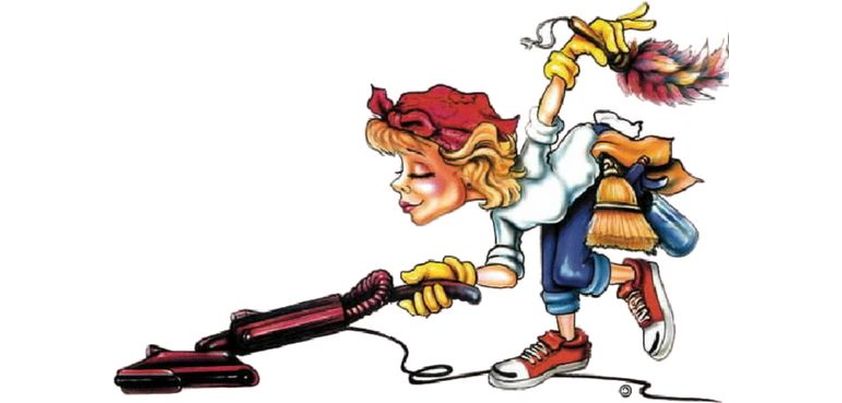 Despite the title, this entertaining first-person narrative by Lucia Berlin focuses more on how to cope with being a cleaning woman than how to do the job. Major themes are the humanity of domestic workers, and the crucial role they can play in client households. The protagonist shares the frustrations of her work, the mind games and other devices she uses to deal with them, the pain of losing her partner, and her habit of stealing sleeping pills from clients for a rainy day. Other themes: camaraderie, life of the city poor, class, loss and loneliness. More…
Despite the title, this entertaining first-person narrative by Lucia Berlin focuses more on how to cope with being a cleaning woman than how to do the job. Major themes are the humanity of domestic workers, and the crucial role they can play in client households. The protagonist shares the frustrations of her work, the mind games and other devices she uses to deal with them, the pain of losing her partner, and her habit of stealing sleeping pills from clients for a rainy day. Other themes: camaraderie, life of the city poor, class, loss and loneliness. More…
Wunderkind
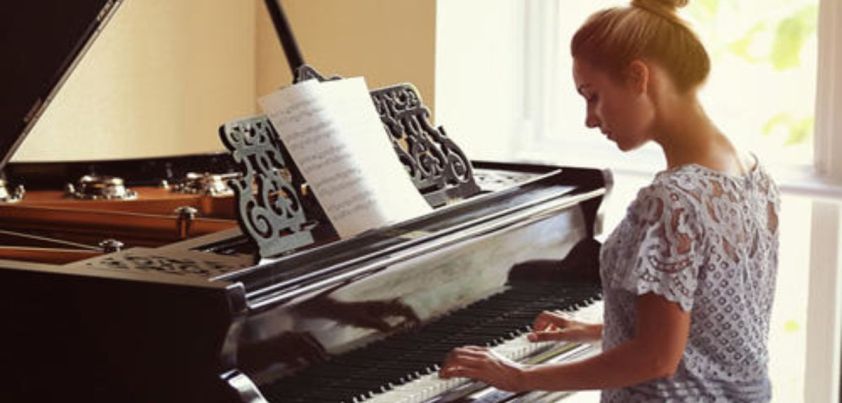 Wunderkind (wonder child) is a German expression for child prodigy. The major theme of this story from Carson McCullers is a problem encountered all over the world: the tendency to place so much pressure to succeed on the shoulders of gifted children that they become discouraged and begin to under-perform. Questions are also raised as to whether the protagonist (fifteen-year-old Frances) has the passion to become a great pianist and, if so, whether her teacher (a well-meaning family friend) is the best one to work with her. Other themes: alienation/loneliness, competitive pressure, fear of failure, sexual confusion, escape. More…
Wunderkind (wonder child) is a German expression for child prodigy. The major theme of this story from Carson McCullers is a problem encountered all over the world: the tendency to place so much pressure to succeed on the shoulders of gifted children that they become discouraged and begin to under-perform. Questions are also raised as to whether the protagonist (fifteen-year-old Frances) has the passion to become a great pianist and, if so, whether her teacher (a well-meaning family friend) is the best one to work with her. Other themes: alienation/loneliness, competitive pressure, fear of failure, sexual confusion, escape. More…
Aquifer
 Aquifer is from Tim Winton’s collection The Turning. Set in an Australian immigrant suburb, the overlapping stories explore life-shaping events in otherwise ordinary lives. Here, a drop in the aquifer brought about by land clearing and prolonged dry weather drains a nearby swamp. A news story about the discovery of human bones at the water’s edge prompts a middle-aged ex-resident to re-live his childhood and the time when, as the only witness, he calmly stood by and watched a neighborhood bully drown. Themes: change, racial stereotyping, perceptions of time. Change is explored on three levels: personal, community and the environment. More…
Aquifer is from Tim Winton’s collection The Turning. Set in an Australian immigrant suburb, the overlapping stories explore life-shaping events in otherwise ordinary lives. Here, a drop in the aquifer brought about by land clearing and prolonged dry weather drains a nearby swamp. A news story about the discovery of human bones at the water’s edge prompts a middle-aged ex-resident to re-live his childhood and the time when, as the only witness, he calmly stood by and watched a neighborhood bully drown. Themes: change, racial stereotyping, perceptions of time. Change is explored on three levels: personal, community and the environment. More…
He
 The central theme of this poignant, rather dark story from Katherine Porter is a mother’s relationship with her devoted special needs son. The woman is obsessed with appearances. Although she professes greater love for him than her other children combined, one wonders if this is out of pity or, worse, a mere show for neighbors. Similarly, are her tears as she takes the boy to the County Home the result of losing him, a sense of failure/shame as a mother, and/or (as the narrator cruelly suggests) wishing he had never been born? Other themes: struggle against poverty, family, appearances, guilt. More…
The central theme of this poignant, rather dark story from Katherine Porter is a mother’s relationship with her devoted special needs son. The woman is obsessed with appearances. Although she professes greater love for him than her other children combined, one wonders if this is out of pity or, worse, a mere show for neighbors. Similarly, are her tears as she takes the boy to the County Home the result of losing him, a sense of failure/shame as a mother, and/or (as the narrator cruelly suggests) wishing he had never been born? Other themes: struggle against poverty, family, appearances, guilt. More…
The Replacement
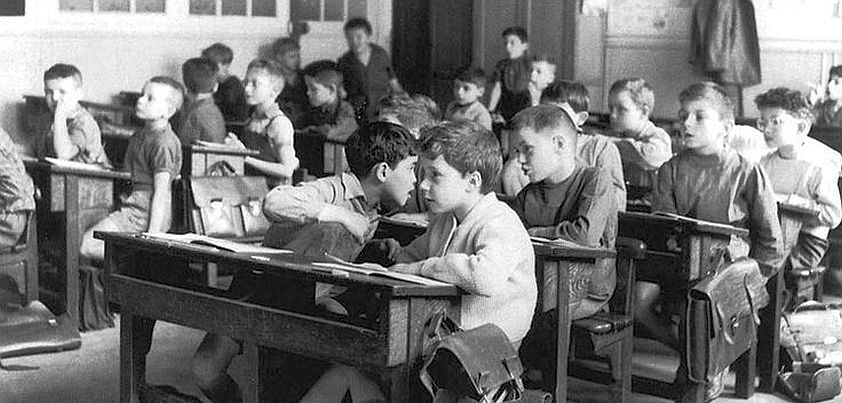 This story by Alain Robbe-Grillet is an example of the Nouveau Roman literary trend of the 1950s. Rather than following a traditional short story structure, The Replacement inter-weaves three seemingly unrelated plot lines involving a frustrated teacher and his bored students, a story they are reading in class, and a schoolboy outside interacting strangely with a tree. In presenting the sequence of events objectively with no authorial interpretation, readers are left to draw their own conclusions as to the story’s meaning and message. Themes could include the attainment of knowledge, the reading process, perseverance, classroom learning vs. curiosity and self-discovery. More…
This story by Alain Robbe-Grillet is an example of the Nouveau Roman literary trend of the 1950s. Rather than following a traditional short story structure, The Replacement inter-weaves three seemingly unrelated plot lines involving a frustrated teacher and his bored students, a story they are reading in class, and a schoolboy outside interacting strangely with a tree. In presenting the sequence of events objectively with no authorial interpretation, readers are left to draw their own conclusions as to the story’s meaning and message. Themes could include the attainment of knowledge, the reading process, perseverance, classroom learning vs. curiosity and self-discovery. More…
The First Seven Years
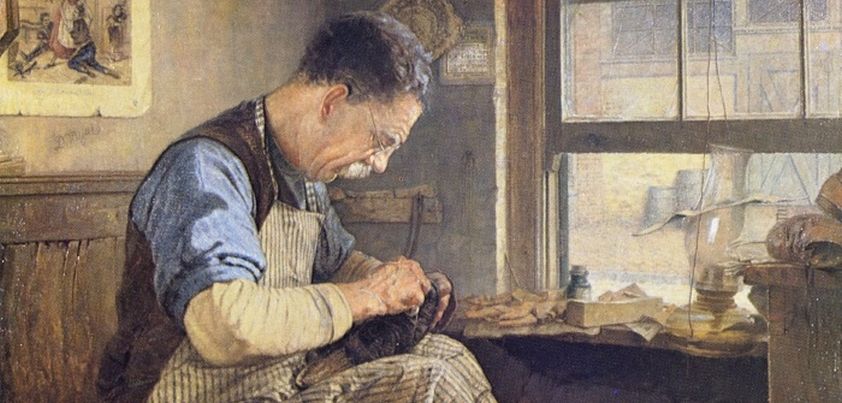 The major theme of this story from Bernard Malamud, with its allusion to the biblical tale of Jacob and Rebecca, is materialism vs. spiritualism. An aging, ailing shoemaker is excited to identify a potential suitor with good financial prospects for his nineteen-year-old daughter. His dreams are shattered when the girl, an avid reader of the classics, rejects the man as being a materialist with “no soul”. He later experiences an epiphany upon learning that she already shares a romantic interest… with his equally sensitive but poorly educated, much older workshop assistant. Other themes: insensitivity, independence, self-learning, worldliness vs. love. More…
The major theme of this story from Bernard Malamud, with its allusion to the biblical tale of Jacob and Rebecca, is materialism vs. spiritualism. An aging, ailing shoemaker is excited to identify a potential suitor with good financial prospects for his nineteen-year-old daughter. His dreams are shattered when the girl, an avid reader of the classics, rejects the man as being a materialist with “no soul”. He later experiences an epiphany upon learning that she already shares a romantic interest… with his equally sensitive but poorly educated, much older workshop assistant. Other themes: insensitivity, independence, self-learning, worldliness vs. love. More…